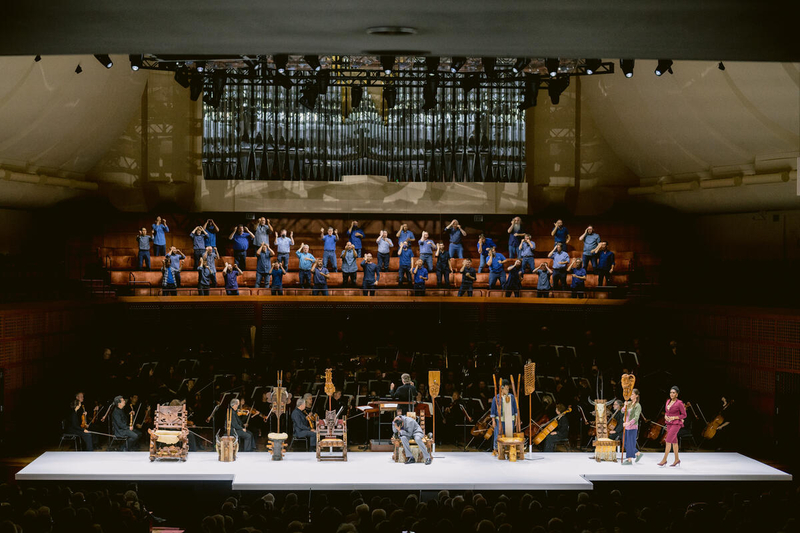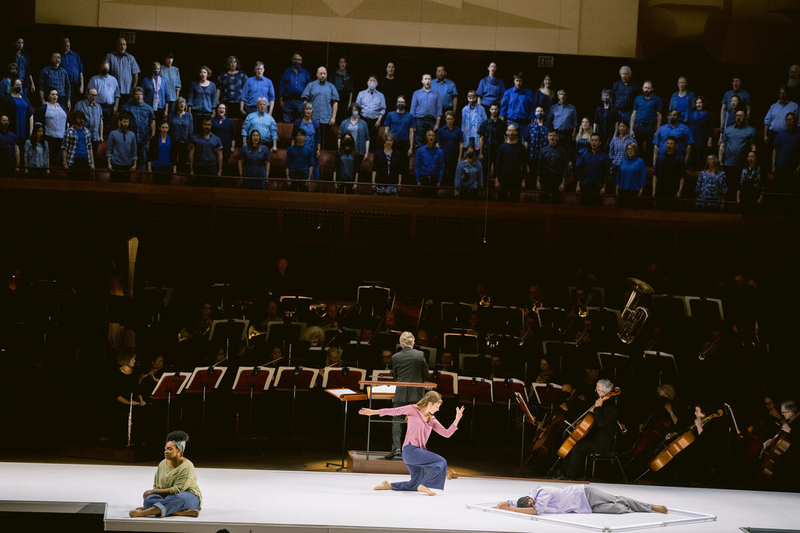Plague infested Thebes, plague infested San Francisco. Esa Pekka Salonen has brought his Peter Sellars staged Oedipus Rex and concluding Stravinsky prayer, Symphony of Psalms, to Davis Hall.
Salonen, now music director of the San Francisco Symphony, former music director of the Los Angeles Philharmonic, has long associated himself with Stravinsky’s operatic oratorio. His debut concert at the LA Phil in 1987 was in fact the Stravinsky/Cocteau tragedy. In 2009 he enlisted wunderkind (then 52 years old) stage director Peter Sellars to stage the tragedy at Disney Hall. Sellars reconsidered and rewrote the part of the narrator, and added the Oedipal salvation offered by Stravinsky’s symphonic prayer. This production was Salonen’s farewell to Los Angeles.
Salonen, music director of London’s Philharmonia (as well as SF Symphony) presented the Sellars staging in 2016 at Royal Festival Hall. This was two months after conducting a fully staged production (by Sellars) at the Aix Festival, performed just hours after the Nice massacre (a truck plowed into a Bastille Day crowd killing 86 people, injuring 458 others, an attack attributed to jihadist terrorism). This civic tragedy resonated inexorably onto these Aix performances. We knew that this massacre was within our collective guilt.
Peter Sellars muse has long been the oppression of peoples of color. This muse has engendered much splendid theater art. At times this art has seemed quite abstract, if not mannered.
Though San Francisco may be in the grips of plague, as was Sophocles’ Thebes, of greater emotive impact is our current confrontation with critical race theory, and its visible effects in our cities and countryside. Thus casting a black actress (Breezy Leigh) as Antigone, an ancient black bass (Willard White) as Creon and Tiresias, a beautiful black woman (J’Nai Bridges) as Jocasta, a young Chicano (Jose Simerilla Romero) as the Shepherd, was hardly coincidence.
And most importantly Sri Lankan/American tenor Sean Panikkar as Oedipus (lead photo) whose leggiero tenor, its warmth of tone, and his sympathetic presence brought inherent innocence to Oedipus, rendering his gradual recognition of guilt painful for us to absorb. Antigone’s searing monologue of his self-inflicted blinding was then absolutely terrifying. And finally, in Stravinsky’s prayerful Symphony of Psalms, the blinded Oedipus’ slow traversal of the stage, led by Antigone’s silent sister Ismene (dancer Laurel Jenkins), was heartbreaking.
Maestro Salonen imposed the emotional distance we needed in a calculated reading of Stravinsky’s neo-classical score. The maestro contained the tensions of its fugues and shattering climaxes, paced its emotional operatic underpinnings, and regimented the outbursts of the citizens of Thebes, the tenors and basses of the San Francisco Symphony Chorus. This without sacrificing the immediacy, the hugeness and the delicacy of this youthful Stravinsky masterpiece.
Stravinsky famously rendered Cocteau’s French text (libretto) into Latin — “a medium not dead but turned to stone.” Cueing from this statement Sellars has the Greek chorus make choreographed, abstracted, uniform motions with their arms while singing, evincing the frozen positions of marble statues. In San Francisco the chorus was seated behind and above the orchestra, immobile and spread out in the chorus loft beneath the pipes of the grand organ, a position that dominated the stage. It was acoustically and visually spectacular, this huge Greek chorus impressively enacted both individually and collectively.
Unlike the 2009 Los Angeles production where the protagonists were placed on a platform behind and above both chorus and orchestra, and amplified, in San Francisco the acting platform was placed stage floor level in front of the orchestra, only the voice of the narrator amplified, the singers well able to project their voices operatically. As well, positioned in front of the orchestra, they established a powerful and immediate presence in the hall.

Over the acting platform, the orchestra and the chorus loft hung 4 huge, black lighting trusses with bevies of lighting instruments hanging from them. An impressive, terrifying sight, it added a monumentality to the proceedings, the deserved monumentality for one of western civilization’s great tragedies. Interestingly this sense of importance was not captured in the fully staged production at the Aix Festival, its space limited to the dimensions of a stage box. As well in Aix the protagonists were white Europeans (with the exception of Willard White, an important bass in Europe at that time). Thus the Aix production was deprived of Sellars fascination of exotic civilizations and the politics of color.
Peter Sellars resolves his sacrificial Oedipus into the songs of salvation and praise of Stravinsky’s Symphony of Psalms, capturing at the conclusion of the first Psalm the magnificence of God by illuminating the pipes of the grand organ in golden light. The chorus is now the full San Francisco Symphony Chorus, again as statues with frozen gestures, singing the Latin texts from Psalms 138,139 and 150, Psalm 150 described by Stravinsky as a dance.

the San Francisco Symphony and Chorus in the Symphony of Psalms
Antigone’s sister Ismene, a Peter Sellars addition to Cocteau’s personae, had silently led all of Stravinsky’s Oedipus Rex actors onto the stage, and then in the Symphony of Psalms she led the blinded, now silent Oedipus across the stage into an illuminated space from which he assumed salvation, and disappeared. She danced this final hymn, adding the silent mystery of an actual human soul to Stravinsky’s extravagant praise of God. Though Stravinsky’s soft, luminously colored C major chord was the final sound of this magical and magnificent performance.
Michael Milenski
Additional production information:
Lighting designer: James F. Ingalls; Costume designer: Helene Siebrits
All photos by Kristen Loken, courtesy of San Francisco Symphony
Davis Hall, San Francisco, June 12, 2022